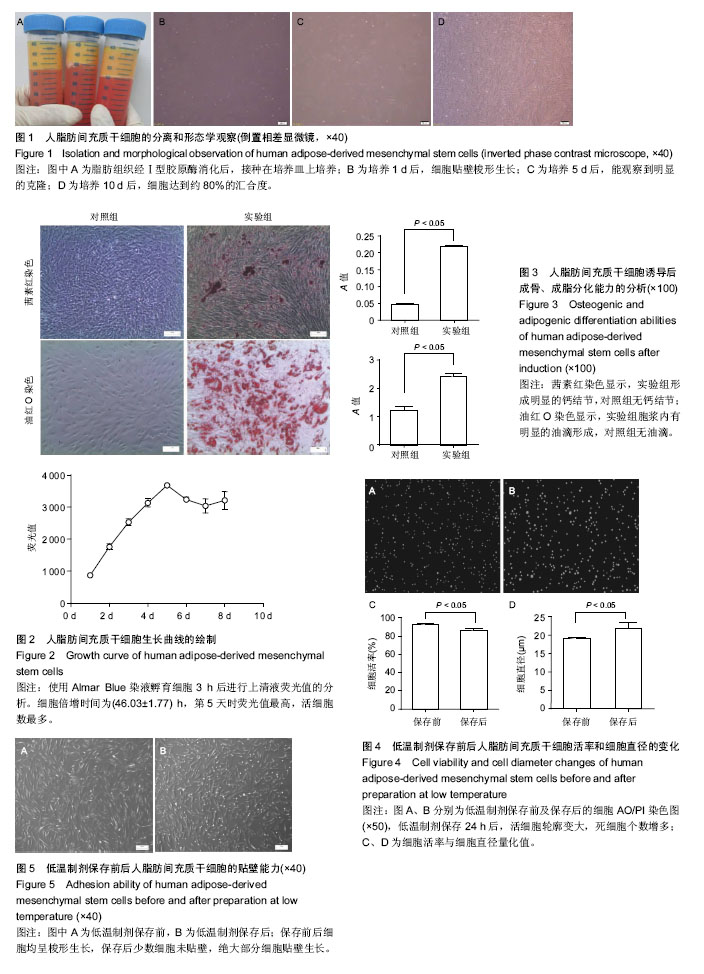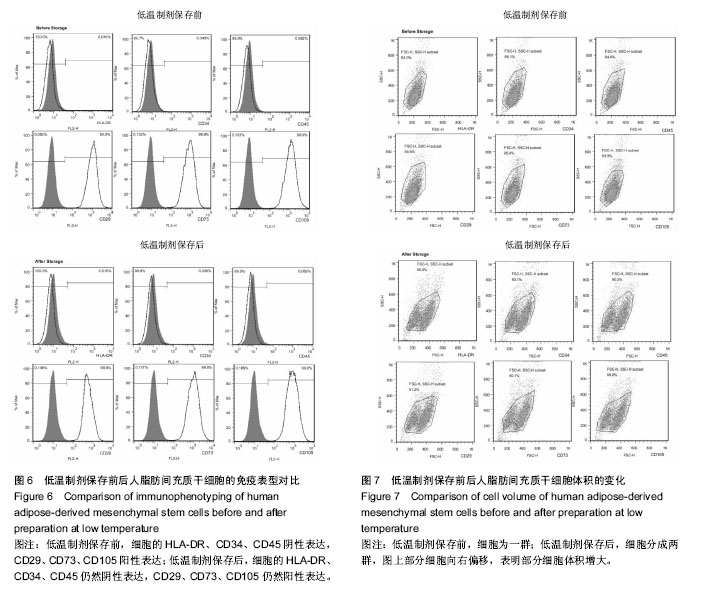| [1] 孙国栋,李志忠.人脐带间充质干细胞在组织工程中的研究进展[J].现代生物医学进展,2009,9(12): 2389-2391.[2] 许倩.人脐带血间充质干细胞的分离培养及向类肝细胞诱导分化的初步研究[D].四川大学,2005.[3] Uzbas F,May ID,Parisi AM,et al.Molecular physiognomies and applications of adipose-derived stem cells.Stem Cell Rev. 2015;11(2):298-308.[4] Wang D,Zhang F,Shen W,et al.Mesenchymal stem cell injection ameliorates the inducibility of ventricular arrhythmias after myocardial infarction in rats.Int J Cardiol. 2011;152(3): 314-320.[5] GOCHCHPAFBTPDBOMOAR Sciences.Summary Basis of Decision (SBD): Prochymal - 2012 - Health Canada.[6] Sánchez-Salinas A,Cabañas‐Perianes V,Blanquer M,et al. An automatic wash method for dimethyl sulfoxide removal in autologous hematopoietic stem cell transplantation decreases the adverse effects related to infusion.Transfusion. 2012; 52(11):2382-2386.[7] 姚永明,张帆,张泽敏,等.不同配比冻存液对兔脂肪干细胞液氮冻存效果的研究[J].中国美容医学,2015, 24(9):29-33.[8] Marquez-Curtis LA,Janowska-Wieczorek A,McGann LE,et al. Mesenchymal stromal cells derived from various tissues: Biological, clinical and cryopreservation aspects. Cryobiology. 2015;71(2):181-197.[9] Marx J,Walls R,Hockberger R.Rosen's emergency medicine- concepts and clinical practice[M]. Elsevier Health Sciences, 2013.[10] Ren H,Sang Y,Zhang F,et al.Comparative analysis of human mesenchymal stem cells from umbilical cord, dental pulp, and menstrual blood as sources for cell therapy.Stem Cells Int. 2016;2016:3516574.[11] Dominici M,Le Blanc K,Mueller I,et al.Minimal criteria for defining multipotent mesenchymal stromal cells. The International Society for Cellular Therapy position statement. Cytotherapy.2006; 8(4):315-317.[12] 王佃亮.细胞药物的标准及质量控制--细胞药物连载之四[J].中国生物工程杂志,2016,36(10):115-121.[13] Cyranoski D.China's stem-cell rules go unheeded.Nature. 2012;484(7393):149-150.[14] 张磊.干细胞创新如何跨越“死亡之谷”[J].中国医药生物技术, 2015,10(5):385-391.[15] Yoshimura K,Suga H,Eto H.Adipose-derived stem/progenitor cells: roles in adipose tissue remodeling and potential use for soft tissue augmentation.Regen Med.2009;4(2):265-273. [16] Bajek A,Gurtowska N,Olkowska J,et al. Adipose-Derived Stem Cells as a Tool in Cell-Based Therapies. Arch Immunol Ther Exp.2016;64(6):443-454.[17] Gomez-Mauricio RG,Acarregui A,Sanchez-Margallo FM,et al.A preliminary approach to the repair of myocardial infarction using adipose tissue-derived stem cells encapsulated in magnetic resonance-labelled alginate microspheres in a porcine model.Eur J Pharm Biopharm. 2013;84(1):29-39. [18] Robinson NJ,Picken A,Coopman K.Low-temperature cell pausing: an alternative short-term preservation method for use in cell therapies including stem cell applications. Biotechnol Lett. 2014;36(2):201-209.[19] Lovelock JE,Bishop MW.Prevention of freezing damage to living cells by dimethyl sulphoxide. Nature. 1959;183(4672): 1394-1395.[20] Marquez-Curtis LA,Janowska-Wieczorek A,McGann LE,et al.Mesenchymal stromal cells derived from various tissues: Biological, clinical and cryopreservation aspects.Cryobiology. 2015;71(2):181-197.[21] Niess H,von Einem JC,Thomas MN,et al.Treatment of advanced gastrointestinal tumors with genetically modified autologous mesenchymal stromal cells (TREAT-ME1): study protocol of a phase I/II clinical trial.BMC Cancer.2015;15:237. [22] Chambers DC,Enever D,Ilic N,et al.A phase 1b study of placenta‐derived mesenchymal stromal cells in patients with idiopathic pulmonary fibrosis.Respirology. 2014;19(7): 1013-1018.[23] Forbes GM,Sturm MJ,Leong RW,et al.A phase 2 study of allogeneic mesenchymal stromal cells for luminal Crohn's disease refractory to biologic therapy.Clin Gastroenterol Hepatol.2014;12(1):64-71. [24] Ikebe C,Suzuki K.Mesenchymal stem cells for regenerative therapy: optimization of cell preparation protocols.Biomed Res Int.2014;2014:951512.[25] Bruder SP,Jaiswal N,Haynesworth SE.Growth kinetics, self‐renewal, and the osteogenic potential of purified human mesenchymal stem cells during extensive subcultivation and following cryopreservation.J Cell Biochem.1997;64(2): 278-294.[26] Rust PA,Tingerides C,Cannon SR,et al.Characterisation of cryopreserved cells freshly isolated from human bone marrow. CryoLetters.2006;27(1):17-28.[27] Hunt L,Hacker DL,Grosjean F,et al.Low-temperature pausing of cultivated mammalian cells. Biotechnol Bioeng.2005;89(2): 157-163.[28] Roobol A,Carden MJ,Newsam RJ,et al.Biochemical insights into the mechanisms central to the response of mammalian cells to cold stress and subsequent rewarming.FEBS J. 2009;276(1): 286-302.[29] Ikebe C,Suzuki K.Mesenchymal stem cells for regenerative therapy: optimization of cell preparation protocols.Biomed Res Int.2014;2014:951512. |
.jpg)


.jpg)